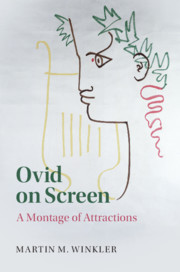Book contents
- Ovid on Screen
- Ovid on Screen
- Copyright page
- Dedication
- Contents
- Illustrations
- Acknowledgments
- D M
- Adages
- Fade-In: Prooemium
- Part I Theory and Practice
- Part II Key Moments in Ovidian Film History
- Part III Into New Bodies
- Part IV Love, Seduction, Death
- Chapter 7 Varieties of Modernism: Orpheus and Eurydice
- Chapter 8 Love and Death
- Chapter 9 Lessons in Seduction
- Part V Eternal Returns
- Sphragis: End Credits
- Bibliography
- Passages of Ovid’s Works
- General Index
- Plate Section (PDF Only)
Chapter 8 - Love and Death
from Part IV - Love, Seduction, Death
Published online by Cambridge University Press: 27 January 2020
- Ovid on Screen
- Ovid on Screen
- Copyright page
- Dedication
- Contents
- Illustrations
- Acknowledgments
- D M
- Adages
- Fade-In: Prooemium
- Part I Theory and Practice
- Part II Key Moments in Ovidian Film History
- Part III Into New Bodies
- Part IV Love, Seduction, Death
- Chapter 7 Varieties of Modernism: Orpheus and Eurydice
- Chapter 8 Love and Death
- Chapter 9 Lessons in Seduction
- Part V Eternal Returns
- Sphragis: End Credits
- Bibliography
- Passages of Ovid’s Works
- General Index
- Plate Section (PDF Only)
Summary
Chapter 8 treats the subject of love and death from two different angles. Ovid’s Heroides is a series of letters by famous women in myth, addressed to their absent husbands, lovers, or sweethearts, some of whom write back. A number of the women writers face imminent death. The first part of this chapter examines the main characteristics of the letters in the Heroides and applies these to one particular, and particularly haunting, film: Max Ophüls’ Letter from an Unknown Woman, based on a novella by Stefan Zweig. In this case, background Ovidianism is especially striking, as can be seen and heard in the opening sentence of the letter written by the film’s heroine to her callous lover: “By the Time You Read This Letter, I May Be Dead.” Who could resist such an opening? The chapter’s second part examines a variety of screen responses to the myth of Philemon and Baucis from the Metamorphoses. These range from a big-budget Hollywood “weepie” (The Notebook) to Mr. Sycamore, an independent production with a quirky not-quite-romance. This little gem deserves renewed appreciation. Discussions of some other European and American productions round off the chapter.
Keywords
- Type
- Chapter
- Information
- Ovid on ScreenA Montage of Attractions, pp. 271 - 301Publisher: Cambridge University PressPrint publication year: 2020

